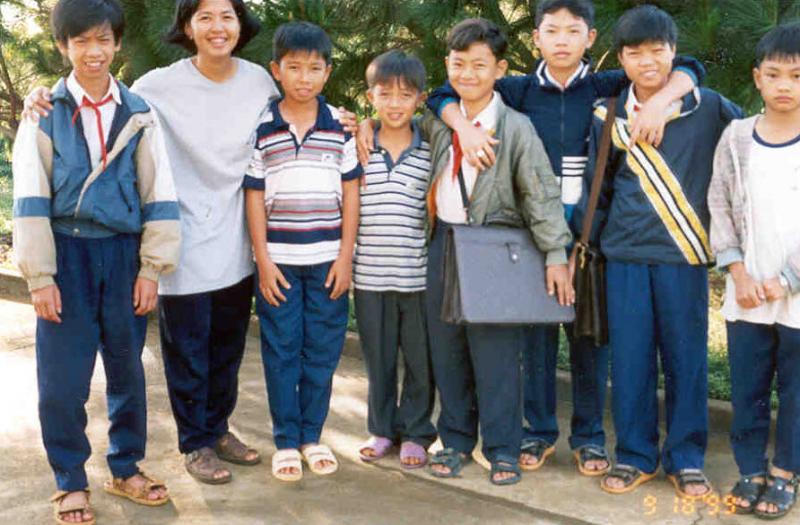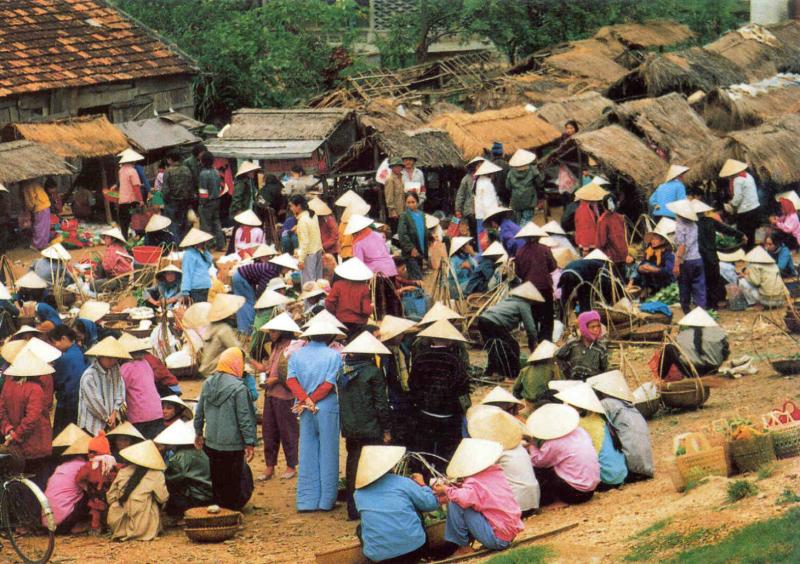Behind The Bamboo Curtain
By Gee-Gee O.Torres
 In 1975, Saigon fell to the Communist forces of North Vietnam. The image of the US embassy staff being helicoptered out dramatically at the last moment had been immortalized in the musical Miss Saigon. Then a bamboo curtain fell in front of the land of rice paddies and pagodas. Inside the curtain a large Catholic population shuddered in fear of what lay ahead. Would it be the end of the Church?
In 1975, Saigon fell to the Communist forces of North Vietnam. The image of the US embassy staff being helicoptered out dramatically at the last moment had been immortalized in the musical Miss Saigon. Then a bamboo curtain fell in front of the land of rice paddies and pagodas. Inside the curtain a large Catholic population shuddered in fear of what lay ahead. Would it be the end of the Church?
A quarter of a century later our editorial assistant, Gee-Gee Torres, ventures behind that curtain to report to the readers of Misyon. Naturally she has had to change names places for security reasons, but I think her story loses nothing in the telling. (Ed)
The flight from Cambodia to Saigon, now called Ho Chi Minh, took only 55 minutes. However it seemed hours to me. I knew my friend Ty was going to meet me at Tan San Nhat Airport. But I felt nervous. I was only relieved when I saw him smiling and holding a “Welcome Gee-Gee” banner outside the airport.
Bicycle Power
He helped me find the place to stay and introduced me to my Vietnamese guide, Thu. The next day I asked Thu if I could possibly visit a Sister’s Convent. She said, “No, problem” and off we went. I tried my best to keep still at the back while Thu maneuvered her motorbike out of the traffic. I was scared like the little boy riding at the back of a bicycle beside us. He was clinging tightly on to his mother’s waist while she was getting ready for the green light. Young ladies on bicycles wearing white ao dai – Vietnamese traditional dress – caught my attention among the motorists. They pedaled sedately and weren’t intimidated by the big noise trucks right behind them nor by the speeding motorbikes which crossed their lane.
Chopstick Lesson

Gee-Gee with school children in Bao Loc
We finally escaped the traffic. We had breakfast at Binh Than Market where you could find all sorts of things – from fruits & vegetables to hardware. I tasted the popular Vietnamese breakfast – noodles topped with beef, mint and kangkong leaves. Thu couldn’t stand watching me struggle with the chopsticks. Eventually she offered to help me and I gladly accepted.
The Calvary of Sr. Hang
I met Sr. Hang at the convent. She has been a sister for 30 years now. She showed me around the convent and pointed out a building which once belonged to them but is now a government school. Then she narrated to me the following:
Before the fall of Saigon I was teaching in our kindergarten and elementary schools. However in 1975, all our properties were taken from us and the government took over our classes. We sisters were allowed to stay and live in the convent but our aspirants had to go back to their home villages. All over Vietnam the churches were forbidden to ring their bells. The government claimed that the bells were putting psychological pressure on Catholics to come to Mass. So the bells went silent. But, lo and behold, the people still came. It seemed that by word of mouth, in whispers and in secret, they passed the message of the time of the Mass on and they were indeed more faithful than ever. The churches were filled up as of old.
The traditional money in Vietnam is called the dong. When the communist took over they did what Marcos did. Overnight the government devalued the money. They created new money. They had a new Vietnam Dong (VND). Even if we had some savings they were now worth nothing. We suddenly found the old dong useless. In the convent we Sisters, now out of work, were given 200 new Vietnam dong and were told to make our way in the world. VND 200 then was only enough to feed our community for a month. (at present $1=VND 14, 000)
Our community decided to keep this money for our medical needs. We went out to work in the fields and garment factories to earn a living; we planted vegetables in the backyard to sell; we ate rice mixed with cracked corn to survive. We were also given a ration ticket which entitled us to buy our basic household needs. For example, we could only by a yard of cloth and a kilo of meat once every month. Sometimes we couldn’t help but laugh when they would give women’s clothes to men they who wanted a new pair of pants or would give a motorbike tire to somebody who needed a new bicycle tire.
Before the war a father could support his family of ten, all the children went to school and the mother just stayed at home. But after 1975, they could hardly eat even if all members of the family were working.
In 1990 the government allowed us to teach again. Our convent re-opened and hundreds of young sisters candidates are in training. Today there are about 7, 400, 000 Catholics in Vietnam, 10% of Vietnams population.
Suddenly I heard myself saying, “Now, I understand.”
“No, you don’t. What you heard is just 1% of what happened,” Sr. Hang countered.
Colonial Past

The following morning I took the plane to Lam Dong Province. Another Vietnamese friend, Krystal, met me at Lien Thuong Airport. She brought me to Da Lat City, dubbed in the old days “Le Petit Paris” of Vietnam. We passed through zigzag roads lined with pine trees. There were many flowers and vegetable plantations along the way. The higher we got, the colder the temperature. Just like our Baguio City in the Philippines. I asked Krystal why almost all of the houses here are of French architecture. She said that the French imperialists built vacation houses here during the years when Vietnam was under French colonial rule.
Full Churches
The next day, Van Van, a friend I met in Thailand, invited me to visit his place in Bao Loc – 85 kms away from Krystal’s place. In recent years the government has allowed a free-market economy so things have changed and people can now acquire properties, just like Van Van’s family who now owns a four hectare coffee plantation. He said that coffee is one of the main products in Vietnam. At least 400, 000 tons are exported every year.
Breath-taking Trip
To my delight he offered to bring back me Saigon on his motorbike the next day. Before we left for Saigon I attended the 5 am Mass in Bao Loc. I left the house at 4:30 in the morning with a group of young boys who were also on their way to the Church. The Church was nearly filled though it was only a daily Mass. I saw mostly old people because the younger ones go to Mass in the evening after school or work. The old women looked beautiful in the ao dai and bandana. I was about to sit with the boys on the pew when Han, the eldest in the group, to me to sit of the left side. I said, “No, I will just join you.” But he insisted that I stay at the other side, explaining that in Vietnam during the Mass men and women sit separately. Interesting. That’s how it was in the Philippines in Spanish times.
The trip from Bao Loc to Saigon was tiring. My hands went numb holding on to Van Van’s shoulder all throughout the five-hour trip. I wanted to stretch my hands, but I was afraid I would fall off the motorbike. The scenery along the way was breath-taking. Mist spilled down from the mountains and hung low on the dark green hills which looked like a tapestry designed with coffee, tea and pine trees. When we were passing by Dong Nai, Van Van said there are about 40,000 Catholics in this province and most of them came from the North. We also passed-by a mountain of covered with banana plants. “The Banana Republic trademark must have originated here,” I joked to myself and then I remembered that that was one of communism’s aims – to rescue countries from Banana Republic status!
Off to Ha Noi
From Saigon, I went up to Ha Noi (the Vietnamese words are normally broken in syllables like this) I planned to take the train but my Vietnamese friends advised me to take the plane. They said that the train ride would take 36 hours and I could not speak Vietnamese except for cam on which means Thank You, not to mention that I was traveling alone.
In Ha Noi I met Thuy who helped me plan my itinerary. She arranged with her trusted motorbike driver to bring me everyday to the different places on my list. I visited St. Joseph’s Cathedral where I met Cardinal Pham Dinh Tung. He’s the third Cardinal of Vietnam which unlike China has diplomatic (if tense) relations with the Vatican and Catholic Church. He initiated the first youth group in the Archdiocese of Ha Noi in 1998. The youth group has about 1, 000 members from the different parishes in Ho Noi. They have Catechism and Mass for the Youth once a month.
Cultural Miracle
Thuy suggested that I should visit Phot Diem, famous fro its Catholic Cathedral built in Buddhist-pagoda style. At first I hesitated because it is three hours away from Ho Noi and I would find myself again in the middle of the traffic just like in Saigon. But in the end I decided to go and it turned out to be one of my unforgettable memories of Vietnam
Seat of the Diocese
Phat Diem Cathedral is exquisite. As I entered the place, I felt like I was in ancient times. I saw a lake in front of a majestic bell tower, then the cathedral proper with five separate chapels and three grottoes around it. I was amazed at the intricate stone and wood carvings, depicting stories of the life of Jesus, Mary and Joseph, inside the Cathedral and the chapels. According to Lich, my Vietnamese guide, the Cathedral was built in 1891 by Fr. Tran Luc, more popularly know as Fr. Six, the then parish priest of Phat Diem. It took Fr. Six more than ten years to gather all the construction materials to build this Cathedral – the seven-ton slab wood for the pillars, the 20 ton slab stone for the altar. This simple parish eventually became the seat of the new diocese in 1901.
Ahead of His Time
The farseeing Fr. Six anticipated the present theology of inculturation and integrated the Catholic faith in the native Vietnamese culture through this unique architectural masterpiece. It resembles as Buddhist temple or pagoda, characterized by several tiers of overhanging curved roofs and adorned with images of saints. It has been recognized by the Ministry of Culture in 1988 as a cultural heritage of Vietnam.
Growing Vocations
Lich introduced me to Bishop Yen of Phat Diem. Vocations in Vietnam are growing. Some 200 candidates await to enter the seminary in every diocese. But each diocese of the country’s 25 dioceses is only allowed by the government to send eight candidates for priesthood every two years. In case a candidate changes his mind or is dismissed from the seminary no replacement is allowed. The government decides who to ordain and when.
In 1954 each diocese had its own seminary but now, for example, in the north there are 8 dioceses but only 1 major seminary. Each parish then had three priests but now two to three parishes only have one priest.
Bells Ring Out
At present the government has loosened some of the reins once tightly held over all religious. Churches are open; Catholics can hear Mass and received the Sacraments. But the Catholic Church is still restricted. Despite this, the once-silenced bell in Phat Diem Cathedral rings out and it is heard all over Vietnam.
CAM ON
Cap & family, Monique, Ty, Van Van, Chinh, Han, Sinh, Krystal, Phuoc, Lam, Tam, Huong, Hang, Phuong, Hin, Thuy, Hoan, Lam Ngoc, Van, Thai, Thanh, Lich, Yen, Nikki, Lia, Junji, Tom, Charlie
Thank you
